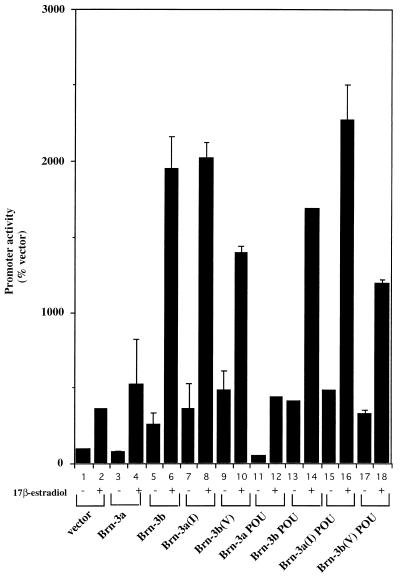FIG. 8.
Brn-3a and Brn-3b have opposite effects on activity of a heterologous promoter containing the ERE sequence only. Luciferase assays were carried out after cotransfection of Brn-3a or Brn-3b and the ERE-containing reporter construct. Transfections were carried out in MCF7 cells, which were grown in phenol red-less medium supplemented with dextran-coated charcoal-stripped serum. Cells were either untreated (−) or were stimulated with 10−8 M 17β-estradiol (+) after transfection. Results are expressed as a percentage of the activity of the empty vector in untreated cells (bar 1). Bar 2 shows the basal activity of the empty vector in stimulated cells, while the effects of overexpression of wild-type Brn-3a (bars 3 and 4) or Brn-3b (bars 5 and 6) on promoter activity in untreated or stimulated cells are shown by bars 3 to 6. Full-length Brn-3a mutants in which the amino acid valine at position 22 of the POU homeodomain was converted to isoleucine of Brn-3b [Brn-3a(I)] were also used (bars 7 and 8). The effect of the reciprocal substitution in Brn-3b (Brn-3b(V) is shown by bars 9 and 10. The effect of cotransfection of expression vectors containing only the POU domain of the Brn-3 proteins is also shown with Brn-3a POU by bars 11 and 12 and with Brn-3b POU by bars 13 and 14. Expression mutants containing the changed amino acid residue in the POU homeodomain, Brn-3a POU(I) and Brn-3b POU(V), were also used in these experiments (bars 15 and 16 and 17 and 18, respectively). These results were reproduced in at least three independent experiments.

